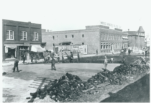Workshop takes beaders on a cultural journey
By Theodora MacLeod - Lethbridge Herald Local Journalism Initiative Reporter on December 19, 2023.
It takes a thousand tiny pieces, a needle sharp enough to break skin, and at times, the patience of a saint. But as attendees of the Galt Museum’s Indigenous Beading workshop last week learned, when all the beads come together, the result can be quite rewarding.Led by experienced beader Deserae Yellow Horn, the class took participants through the steps of making beaded rope lanyards using a wrap-around method. The supplies; paracord, nylon thread, beading needles, and so many shiny tiny beads (roughly size 10 or 11) in an array of hues and tones.
Yellow Horn says she’s been beading for quite a while, learning at 14 years-old while attending an Indigenous-focused alternative schooling program through the Napi Friendship Centre in Pincher Creek.
Over the years she has hosted workshops through the Galt and the University of Lethbridge Art Gallery. Her work can be seen on one of the crowns for last year’s Piikani Nation Pow Wow.
In recent years there seems to have been a crafting revival, a resurgence of D.I.Y and creating that can be traced back to the pandemic era lockdowns. Beading is no exception and Yellow Horn suspects it’s thanks to the ease of teaching it online.
But while COVID is an obvious cause, another key element is the growing platform give to Indigenous culture in an effort to foster reconciliation.
“I think that there has been more attention paid to Indigenous arts, so of course beadwork is automatically what people think about when they think about Indigenous art,” explains Yellow Horn.
However, the beadwork seen today, the earrings and lanyards and brilliantly eye-catching embellishments to regalia, is not the same as was practiced pre-colonization.
“Originally the beadwork was quill work so it was porcupine quills that were used and dyed different colours and then they were braided into pieces. So you would see things like belts, or pipe bags, or even moccasins that were braided or had the quill work on them.”
She says that working with quills was no small feat, so when Chinese immigrants began settling in Canada in the late 18th century and brought glass beads with them, they eventually became the tool of choice for many Indigenous creators.
“The glass beads were seen as easier because porcupine quills were also dangerous to use. They caused, I think, heart disease for people that would use them excessively. And plus, it just hurts to use porcupine quills because you don’t know if you’re going to get stuck with one.
“Over the last 100 years, glass beads have really rose in popularity amongst Indigenous beaders and quill work is to the side now. But as of lately, quill work has kind of started to rise once again.
“But there’s only certain people that know how to do it, so similar to beadwork it has to be taught. It takes a while to actually learn how to do quill work; I would argue that it takes longer.”
And not just longer, Yellow Horn says the whole practice is far more laborious.
“You have to think about getting the quills and dying the quills, and cleaning the quills, so there’s an entire process in just making the quills to the standard of what you’re wanting, especially if you’re wanting to do coloured quill work… I mean even getting quills can be dangerous because you basically have to get them from a porcupine… with glass beads you don’t have to wrestle anything for that.”
Since establishing itself as the popular method of embellishing for Indigenous peoples in the 20th century, Yellow Horn says the designs and colours have evolved, like any aspect of fashion would.
“A common belief is that Blackfoot would only use geometrics, however, there’s pieces from early 1900s that actually show we did floral pieces and then moved to geometrics throughout the 20th century.”
As awareness of cultural appropriation rises, many non-indigenous people fear taking up beading will be seen as offensive. But Yellow Horn says it’s the difference between appropriation and appreciation.
“Because every culture has beadwork, it’s not necessarily seen as cultural appropriation, as long as you’re not creating specific Indigenous patterns and then going out saying ‘oh an Indigenous person made this,’ then that would be considered cultural appropriation, but it can be cultural appreciation.”
She explains that certain items like beaded pipe bags and belts are more specific to Indigenous culture.
At the end of the night the small group of rookie beaders left with a new skill and supplies to finish their lanyards. 2
-1




